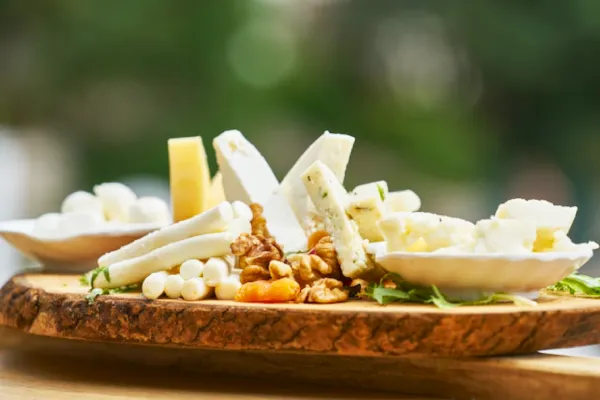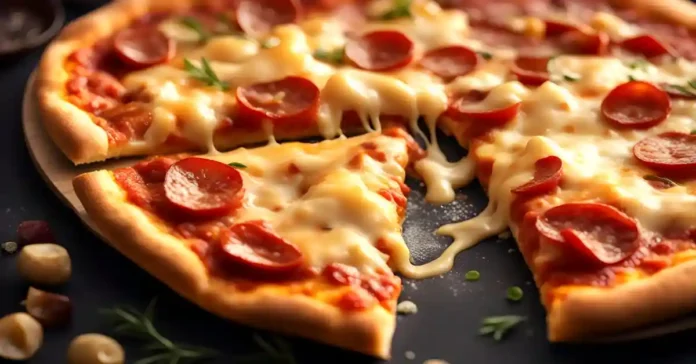So, how our favourite pizza cheese is crafted? In this comprehensive guide, we will go into the step-by-step process of “How Pizza Cheese is Made.” From the dairy farm to our plate, we’ll explore the journey of turning milk into that perfect melty, pizza topping.
Starting with the Right Milk: The Beginnings of How Pizza Cheese is Made
The journey of pizza cheese begins with one fundamental choice – selecting the right type of milk.
Most often, cow’s milk takes center stage in the cheese-making process. But the choice of milk is just the beginning of “How Pizza Cheese is Made.”
The type of milk can significantly influence the final flavor and texture of the cheese.
The Cheese-Making Process: A Key Part
Pasteurization: The First Step in How Pizza Cheese is Made
The story begins with pasteurization, This process involves heating the milk to a specific temperature. The aim? To eliminate harmful bacteria while retaining essential enzymes and proteins.
It’s all about ensuring the cheese is safe to eat.
Curd Formation
After pasteurization, we dive into curd formation. Starter cultures and enzymes are introduced to the milk, initiating the transformation of lactose into lactic acid.
This is where the foundation of cheese creation takes place.
Coagulation: A Key Moment in How Pizza Cheese is Made The milk thickens and forms curds, thanks to the cultures and enzymes.
Achieving the right level of coagulation is a pivotal part of “How Pizza Cheese is Made.”
Cutting and Draining: The curd mass is cut into smaller pieces, separating them from the liquid whey. Draining the whey leaves us with the curds – the raw material for our pizza cheese.
Salting: Adding Flavour
Salt is introduced into the cheese to enhance its flavor and help preserve it.
The salt content also affects the cheese’s moisture levels, a critical factor in pizza cheese production.
Balancing Moisture and Fat: The Secret to Perfectly Melted Cheese
What makes pizza cheese stand out is its ability to melt beautifully, creating that signature stretch and browning.
Achieving this ideal consistency requires a fine balance of moisture and fat content.
Low-Moisture Mozzarella
Made Low-moisture Mozzarella plays a pivotal role in “How Pizza Cheese is Made.” With its firmer texture, it grates easily, melts beautifully, and achieves the perfect browning.
This variety has transformed pizza making.
Fat-in-Dry-Matter Content: A Crucial Element
Made An essential aspect of cheese quality is the fat-in-dry-matter content, usually within the 35-40% range.
This balance ensures a creamy, rich flavor without compromising the cheese’s structure.
Varieties and Blends: Crafting Unique Flavours

Pizza cheese isn’t a one-size-fits-all product.
It often involves blending different cheeses to achieve the desired flavor profile. Here are some popular varieties:
Mozzarella : The star of the show, known for its meltability and mild flavor.
Provolone : Adds a hint of sharpness to the blend, enhancing the overall taste.
Cheddar : Known for its bold and distinct flavor, often mixed with mozzarella to maintain chewiness.
Parmesan : A popular topping, adding a rich, savory taste and a hint of nuttiness.
Emmental and Romano : These cheeses bring unique flavors and textures to different pizza styles.
Ricotta : Used for a creamy filling in calzones or as a topping, offering a twist to traditional pizza.
Analogue Pizza Cheese: Quick and Affordable Alternatives
Mass-produced pizzas often turn to analog (or analog) pizza cheese for quick and cost-effective solutions.
It’s designed to melt well and maintain a chewy texture, ideal for fast-food settings.
Provel : A well-known example, it’s a blend of Cheddar, Swiss, and Provolone cheeses, created for quick and consistent melting.
Casein-Based Variants : Some analog types use casein, a by-product of milk, and vegetable oil, instead of milk fat.
Innovations in Pizza Cheese Production: Striving for Perfection
Constant research and experimentation aim to improve pizza cheese’s stretchiness, meltability, browning, and overall quality.
Stabilizers : Innovative stabilizer systems have been developed to enhance the meltability of low-fat pizza cheese, resulting in better performance during cooking.
Galactose Content : Reducing the level of galactose, a type of sugar, can improve cheese stretchiness.
Denatured Whey Proteins : While they increase moisture retention slightly, the economic value of these improvements is often minimal.
Production Techniques : Some cheese manufacturers use direct acidification and specific temperature and time combinations to enhance cheese properties, resulting in better meltability.
Production and Business : Satisfying the Demand for Pizza Cheese
The love for pizza cheese keeps growing.
In the United States, several hundred million pounds of pizza cheese are consumed annually, with demand continuing to rise.
Mass production is essential to meet this demand, with companies like Leprino Foods leading the way.
Leprino Foods Company, for instance, processes over 600,000 tonnes of pizza cheese annually.
Their innovative production processes enable the quick creation of high-quality cheese, contributing significantly to the pizza industry’s growth.
Use by Region : Pizza Cheese Preferences
Pizza cheese preferences can vary by region.
Whole milk mozzarella is popular in the East and Southwest regions of the U.S., while Provolone dominates the coasts.
Cheddar is more common in the Eastern and Southern regions of the U.S. Regional preferences contribute to the unique character of pizza styles across the country.
Conclusion: The Craft of Making Pizza Cheese
Pizza cheese isn’t just an ingredient; it’s a vital part of the pizza experience.
From choosing the right milk to balancing moisture and fat, crafting pizza cheese is a craft in itself.
The next time you savour a slice of pizza, remember the careful process and ingenuity that transform milk into that mouth-watering melt, making it an essential part of your pizza experience.
